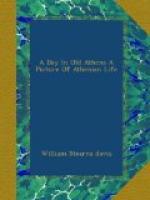The front section of the house is now open to us, but it is time to penetrate farther. Directly behind the open court is a sizable chamber forming a passage to the inner house. This chamber is the Andron, the dining hall and probably the most pretentious room in the house. Here the guests will gather for the dinner party, and here in one corner smokes the family hearth, once the real fire for the whole household cooking, but now merely a symbol of the domestic worship. It is simply a little round alter sacred to Hestia, the hearth goddess,[*] and on its duly rekindled flame little “meat offerings and drink offerings” are cast at every meal, humble or elaborate.
[*]Who corresponds to the Roman goddess Vesta.
In the rear wall of the Andron facing the Andronitis is a solid door. We are privileged guests indeed if we pass it. Only the father, sons, or near male kinsmen of the family are allowed to go inside, for it leads into the Gyneconitis, the hall of the women. To thrust oneself into the Gyneconitis of even a fairly intimate friend is a studied insult at Athens, and sure to be resented by bodily chastisement, social ostracism, and a ruinous legal prosecution. The Gyneconitis is in short the Athenian’s holy of holies. Their women are forbidden to participate in so much of public life that their own peculiar world is especially reserved to them. To invade this world is not bad breeding; it is social sacrilege.
In the present house, the home of a well-to-do family, the Gyneconitis forms a second pillared court with adjacent rooms of substantially the same size and shape as the Andronitis. One of the rooms in the very rear is proclaimed by the clatter of pots and pans and the odor of a frying turbot to be the kitchen; others are obviously the sleeping closets of the slave women. On the side nearest to the front of the house, but opening itself upon this inner court, is at least one bed chamber of superior size. This is the Thalamos, the great bedroom of the master and mistress, and here are kept all the most costly furnishings and ornaments in the house. If there are grown-up unmarried daughters, they have another such bedroom (anti-thalamos) that is much larger than the cells of the slave girls. Another special room is set apart for the working of wool, although this chief occupation of the female part of the household is likely to be carried on in the open inner court itself, if the weather is fine. Here, around a little flower bed, slave girls are probably spinning and embroidering, young children playing or quarreling, and a tame quail is hopping about and watching for a crumb. There are in fact a great many people in a relatively small space; everything is busy, chattering, noisy, and confusing to an intruding stranger.




